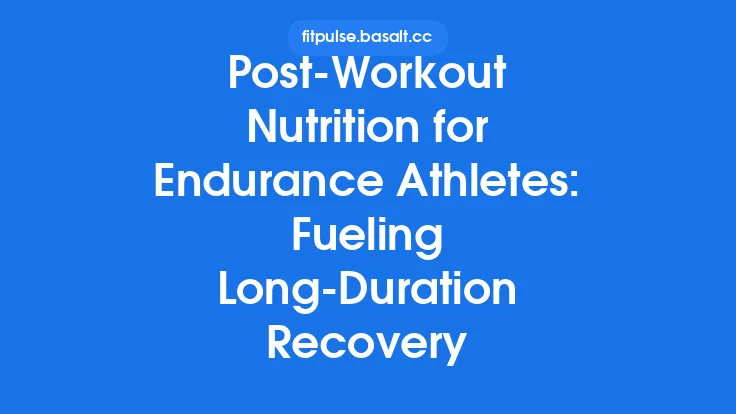Endurance performance in masters athletes hinges on more than just mileage and mileage‑based training; the fuel you provide your body determines how efficiently you can sustain effort, recover between sessions, and stay competitive over the long term. As we age, physiological changes—such as reduced muscle mass, altered hormone profiles, and slower gastric emptying—necessitate a nuanced approach to nutrition. Below is a comprehensive, evergreen guide that outlines the key principles and practical strategies to optimize your diet for endurance success after 50.
Understanding Energy Requirements
Basal Metabolic Rate (BMR) and Activity Thermogenesis
- BMR declines ~1–2 % per decade after the third decade of life, largely due to loss of lean tissue.
- Total Daily Energy Expenditure (TDEE) for masters endurance athletes typically ranges from 2,200 to 3,500 kcal, depending on training volume, body size, and metabolic efficiency.
Adjusting for Training Load
- Low‑volume (≤5 h/week): add ~300–500 kcal to BMR.
- Moderate‑volume (5–10 h/week): add ~500–800 kcal.
- High‑volume (>10 h/week): add ~800–1,200 kcal.
Why It Matters
Under‑fueling accelerates loss of lean mass and impairs glycogen replenishment, while chronic over‑fueling can lead to unwanted weight gain and reduced VO₂max efficiency.
Carbohydrate Strategies for Endurance
Role of Carbohydrates
- Primary substrate for high‑intensity efforts (>65 % VO₂max).
- Supports glycogen storage in muscle (≈400–500 g) and liver (≈100 g).
Daily Intake Recommendations
| Training Intensity | g CHOs / kg body weight / day |
|---|---|
| Light (≤1 h, low intensity) | 3–5 |
| Moderate (1–2 h, mixed intensity) | 5–7 |
| Heavy (>2 h, high intensity) | 7–10 |
| Ultra‑endurance (>4 h) | 8–12 |
Timing Around Workouts
- Pre‑exercise (2–3 h): 1–4 g CHOs / kg, low‑fiber, moderate‑glycemic foods (e.g., oatmeal with fruit).
- During exercise (>60 min): 30–60 g CHOs per hour (sports drinks, gels, or fruit).
- Post‑exercise (within 30 min): 1–1.2 g CHOs / kg plus 0.2–0.3 g protein / kg to maximize glycogen resynthesis.
Choosing Quality Carbohydrates
- Emphasize whole grains, legumes, fruits, and starchy vegetables for micronutrient density.
- Use simple sugars strategically during long sessions to maintain blood glucose without gastrointestinal distress.
Protein: Preserving Lean Mass and Supporting Recovery
Why Protein Is Critical
- Age‑related anabolic resistance reduces muscle protein synthesis (MPS) response to protein intake.
- Adequate protein mitigates sarcopenia and aids repair of micro‑damage from repetitive endurance loading.
Recommended Intake
- 1.2–1.6 g protein / kg body weight / day for most masters endurance athletes.
- For those training >10 h/week or incorporating strength sessions, aim toward the upper end (≈1.6 g/kg).
Distribution
- 4–5 meals spread evenly across the day, each containing 0.25–0.4 g protein / kg (≈20–30 g for a 70 kg athlete).
- Include high‑leucine sources (≥2.5 g leucine per serving) such as whey, Greek yogurt, soy, or lean meats.
Protein Quality
- Prioritize complete proteins (animal sources) or complementary plant proteins (e.g., rice + beans).
- Consider digestibility‑corrected amino acid score (PDCAAS) when planning vegetarian meals.
Fats: Energy, Hormones, and Inflammation Control
Essential Roles
- Provide ≥20 % of total calories for endurance fuel during low‑intensity, long‑duration efforts.
- Supply fat‑soluble vitamins (A, D, E, K) and essential fatty acids (EPA/DHA) that modulate inflammation and joint health.
Guidelines
- Total fat intake: 0.8–1.0 g fat / kg body weight / day.
- Omega‑3 fatty acids: 1–2 g EPA/DHA combined daily (fatty fish, algae supplements).
Practical Sources
- Monounsaturated fats: olive oil, avocado, nuts.
- Polyunsaturated fats: flaxseed, chia seeds, walnuts.
- Saturated fats: limit to <10 % of total calories; choose minimally processed sources (e.g., dairy, lean meat).
Micronutrients: The Small Players with Big Impact
| Micronutrient | Why It Matters for Masters Endurance | Key Food Sources | Recommended Intake (Adults) |
|---|---|---|---|
| Iron | Supports oxygen transport; deficiency reduces VO₂max. | Red meat, poultry, lentils, fortified cereals. | 8 mg (men), 18 mg (women) – higher if training >10 h/week. |
| Calcium | Bone density maintenance; crucial for muscle contraction. | Dairy, fortified plant milks, leafy greens. | 1,200 mg. |
| Vitamin D | Enhances calcium absorption; modulates immune function. | Sunlight, fatty fish, fortified foods. | 800–1,000 IU. |
| Magnesium | Involved in ATP production and muscle relaxation. | Nuts, seeds, whole grains, legumes. | 420 mg (men), 320 mg (women). |
| B‑Vitamins | Energy metabolism (glycolysis, TCA cycle). | Whole grains, meat, eggs, legumes. | Varies; aim for a balanced B‑complex intake. |
| Antioxidants (Vitamin C, E, Selenium, Polyphenols) | Counteract oxidative stress from prolonged training. | Berries, citrus, nuts, green tea, dark chocolate. | Meet RDA; consider food‑based sources over high‑dose supplements. |
Testing and Monitoring
- Periodic blood panels (every 6–12 months) help identify subclinical deficiencies, especially iron, vitamin D, and B12 in vegetarians.
Hydration and Electrolyte Management
Fluid Balance Fundamentals
- Sweat loss can range from 0.5–2 L / hour depending on climate and intensity.
- Dehydration >2 % body mass impairs performance and thermoregulation.
Daily Hydration Targets
- Baseline: 30–35 mL / kg body weight (e.g., 2.1–2.5 L for a 70 kg athlete).
- During training: Replace 150–250 mL every 15–20 min; adjust for heat and humidity.
Electrolyte Replacement
- Sodium: 300–600 mg / L of fluid during prolonged sessions.
- Potassium, magnesium, calcium: modest amounts via sports drinks or food (bananas, dried apricots, nuts).
Practical Tips
- Use personalized sweat testing (urine color, body weight change) to fine‑tune fluid plans.
- Incorporate electrolyte tablets or low‑sugar sports drinks for sessions >90 min.
Meal Timing and Periodic Nutrition Planning
Pre‑Training Nutrition
- Aim for a light, carbohydrate‑rich snack 30–60 min before training if you cannot eat a full meal.
- Example: a banana with a tablespoon of almond butter (≈30 g CHO, 5 g protein).
Post‑Training “Anabolic Window”
- Within 30 minutes, consume a recovery snack containing a 3:1 carbohydrate‑to‑protein ratio.
- Example: chocolate milk (≈40 g CHO, 10 g protein) or a smoothie with whey protein, fruit, and oat milk.
Daily Rhythm
- Breakfast: Prioritize complex carbs and protein to replenish overnight glycogen and stimulate MPS.
- Lunch/Dinner: Balanced plates (½ vegetables, ¼ lean protein, ¼ whole grains) to sustain energy and micronutrient intake.
- Evening snack (if needed): Small protein source (cottage cheese, Greek yogurt) to support overnight recovery.
Supplementation: Evidence‑Based Options
| Supplement | Primary Benefit | Typical Dose | Evidence Summary |
|---|---|---|---|
| Whey Protein | Rapid MPS activation | 20–30 g post‑exercise | Strong support for muscle repair in older adults. |
| Beta‑Alanine | Buffers muscle acidity, improves high‑intensity endurance | 2–5 g/day (split doses) | Effective for efforts >4 min; safe for seniors. |
| Caffeine | Enhances alertness, reduces perceived effort | 3–6 mg/kg 30 min pre‑exercise | Proven performance boost; monitor tolerance. |
| Beetroot Juice (Nitrates) | Improves oxygen efficiency, lowers heart rate at given workload | 300–500 mL (≈6 mmol nitrate) 2–3 h before | Beneficial for sub‑maximal endurance; minimal side effects. |
| Omega‑3 (EPA/DHA) | Anti‑inflammatory, supports joint health | 1–2 g/day | Supports recovery and cardiovascular health. |
| Vitamin D (if deficient) | Bone health, immune function | 1,000–2,000 IU/day (adjusted to serum levels) | Corrects deficiency; improves muscle function. |
| Iron (if low) | Improves oxygen transport | 18 mg elemental iron/day (as ferrous sulfate) | Only when labs confirm deficiency; avoid excess. |
Caution
- Avoid megadoses of antioxidants (e.g., >1,000 mg vitamin C) as they may blunt training adaptations.
- Always consult a healthcare professional before initiating new supplements, especially if you have chronic conditions or take medication.
Practical Meal Planning for the Masters Endurance Athlete
Sample 2,500 kcal Day (70 kg athlete, moderate training)
| Time | Meal | Approx. Nutrients |
|---|---|---|
| 07:00 | Breakfast – 1 cup oatmeal, ½ cup blueberries, 1 tbsp chia seeds, 1 scoop whey protein, 250 mL low‑fat milk | 55 g CHO, 30 g protein, 10 g fat |
| 10:00 | Snack – Greek yogurt (150 g) + 1 tbsp honey + 20 g almonds | 25 g CHO, 15 g protein, 12 g fat |
| 12:30 | Lunch – Grilled salmon (150 g), quinoa (¾ cup cooked), mixed greens with olive oil vinaigrette | 45 g CHO, 35 g protein, 18 g fat |
| 15:30 | Pre‑run snack – Banana + 1 tbsp peanut butter | 30 g CHO, 5 g protein, 8 g fat |
| 17:30 | Post‑run recovery – Chocolate milk (250 mL) + 1 slice whole‑grain toast | 45 g CHO, 12 g protein, 5 g fat |
| 19:30 | Dinner – Turkey meatballs (150 g), whole‑wheat pasta (1 cup), marinara sauce, steamed broccoli | 55 g CHO, 35 g protein, 10 g fat |
| 21:30 | Evening snack – Cottage cheese (½ cup) with sliced peach | 15 g CHO, 14 g protein, 2 g fat |
| Total | ~300 g CHO (48 % kcal), ~166 g protein (27 % kcal), ~70 g fat (25 % kcal) |
Adjustments
- Increase carbohydrate portions on high‑volume weeks.
- Swap animal proteins for plant‑based equivalents (tofu, tempeh) while maintaining leucine content.
- Add extra omega‑3 sources (e.g., sardines) on recovery‑focused days.
Adapting Nutrition to Age‑Related Physiological Changes
- Reduced Gastric Emptying – Opt for lower‑fiber, moderate‑glycemic meals 1–2 h before intense sessions to avoid bloating.
- Blunted Anabolic Response – Distribute protein evenly and consider leucine‑rich supplements to overcome resistance.
- Altered Taste and Appetite – Incorporate flavorful herbs, spices, and varied textures to maintain adequate intake.
- Bone Health Concerns – Prioritize calcium‑rich foods and vitamin D; combine with weight‑bearing activities for synergistic effect.
- Metabolic Flexibility – Include periodic low‑carb days (e.g., 1–2 per week) to enhance fat oxidation without compromising overall glycogen stores.
Monitoring Progress and Making Adjustments
- Body Composition: Use skinfold calipers or bioelectrical impedance quarterly to track lean mass vs. fat mass.
- Performance Markers: Record race times, training paces, and perceived exertion; correlate with dietary changes.
- Blood Biomarkers: Check ferritin, vitamin D, B12, and lipid profile annually.
- Hydration Status: Weigh yourself pre‑ and post‑training; aim for ≤1 % body mass loss.
- Subjective Measures: Keep a nutrition log noting energy levels, GI comfort, and sleep quality.
When trends indicate fatigue, weight loss, or performance plateaus, revisit macronutrient ratios, protein timing, and micronutrient adequacy.
Common Pitfalls and How to Avoid Them
| Pitfall | Why It Happens | Solution |
|---|---|---|
| Undereating due to “slower metabolism” myth | Over‑reliance on BMR calculators without accounting for training load. | Calculate TDEE with activity factor; adjust based on weight trends. |
| Excessive reliance on “quick fixes” (e.g., high‑caffeine energy drinks) | Seeking immediate performance boost without considering overall diet. | Use caffeine strategically; prioritize whole‑food nutrition. |
| Skipping post‑exercise nutrition | Belief that endurance training doesn’t cause muscle damage. | Implement a 3:1 CHO‑protein snack within 30 min after each session. |
| Neglecting micronutrients | Focus on calories/macros only. | Schedule a weekly “micronutrient audit” (e.g., colorful plate rule). |
| Over‑supplementation | Perception that more is better. | Stick to evidence‑based doses; prioritize food sources first. |
Final Thoughts
Nutrition for masters endurance athletes is a dynamic, lifelong partnership between the body’s evolving needs and the foods we choose to fuel it. By:
- Quantifying energy demands and adjusting for training volume,
- Strategically timing carbohydrates to protect glycogen stores,
- Ensuring sufficient high‑quality protein to counteract anabolic resistance,
- Incorporating healthy fats and essential micronutrients for overall health,
- Managing hydration and electrolytes with precision, and
- Employing evidence‑based supplements only when needed,
you create a robust nutritional foundation that supports not just faster race times, but also sustained health, injury resilience, and enjoyment of the sport well into later years. Regular monitoring, flexibility in the plan, and a focus on whole, nutrient‑dense foods will keep you performing at your best—no matter how many miles you log or how many birthdays you celebrate.





